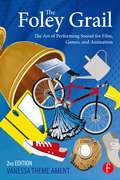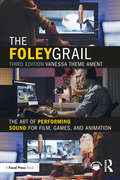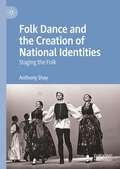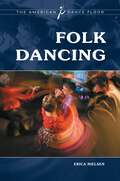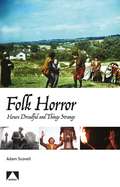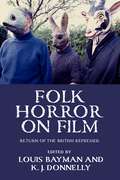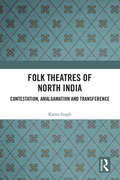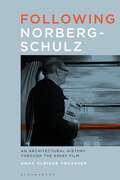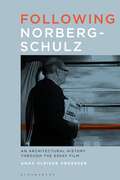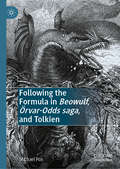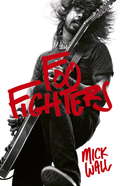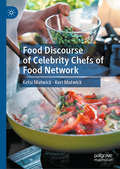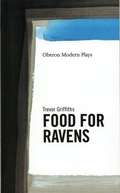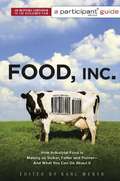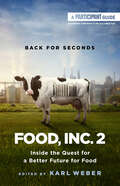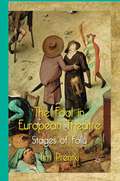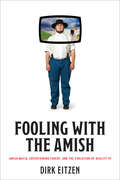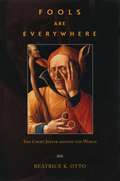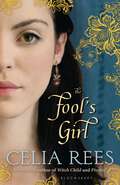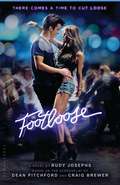- Table View
- List View
The Foley Grail: The Art of Performing Sound for Film, Games, and Animation
by Vanessa Theme AmentMaster classic and cutting-edge Foley techniques that will allow you to create rich, convincing sound for any medium, be it film, television, radio, podcasts, animation, or games. In The Foley Grail, Second Edition award-winning Foley artist Vanessa Theme Ament teaches you how Foley is designed, crafted, and edited for any project, right down to the nuts and bolts of spotting, cueing, and performing sounds. Various renowned sound artists provide a treasure trove of shortcuts, hot tips, and other tricks of the trade. This new edition features: Entirely new chapters dedicated to Foley in games, television, broadcasting, and animation, as well as what is new in sound for media education All new sound "recipes" that include proven Foley methods you can immediately use on your own projects New case studies from well-known films, shows, games, and animations Interviews with current sound artists from across the globe An extensive companion website (www.focalpress.com/cw/ament) featuring video demonstrations of Foley artists at work, video tutorials of specific Foley techniques, lectures from the author, and much more
The Foley Grail: The Art of Performing Sound for Film, Games, and Animation
by Vanessa Theme AmentMaster classic and cutting-edge Foley techniques that will allow you to create rich, convincing sound for any medium, be it film, television, radio, podcasts, animation, or games. In The Foley Grail, Second Edition award-winning Foley artist Vanessa Theme Ament teaches you how Foley is designed, crafted, and edited for any project, right down to the nuts and bolts of spotting, cueing, and performing sounds. Various renowned sound artists provide a treasure trove of shortcuts, hot tips, and other tricks of the trade. This new edition features: Entirely new chapters dedicated to Foley in games, television, broadcasting, and animation, as well as what is new in sound for media education All new sound "recipes" that include proven Foley methods you can immediately use on your own projects New case studies from well-known films, shows, games, and animations Interviews with current sound artists from across the globe An extensive companion website (www.focalpress.com/cw/ament) featuring video demonstrations of Foley artists at work, video tutorials of specific Foley techniques, lectures from the author, and much more
The Foley Grail: The Art of Performing Sound for Film, Games, and Animation
by Vanessa Theme AmentThis book teaches you how to master classic and cutting edge Foley techniques in order to create rich and convincing sound for any medium, be it film, television, radio, podcasts, animation, or games. Award-winning Foley artist Vanessa Theme Ament demonstrates how Foley is designed, crafted, and edited for any project, down to the nuts and bolts of spotting, cueing, and performing sounds. Various renowned sound artists provide a treasure trove of indispensable shortcuts, hot tips, and other valuable tricks of the trade. This updated third edition features the following: New chapters dedicated to Foley in games, television, broadcasting, and animation, as well as what is new in sound for media education A multitude of sound "recipes" that include proven Foley methods you can immediately use on your own projects A diverse range of case studies from well-known films, shows, games, and animation Interviews with current sound artists from around the world By exploring the entire audio post-production process, this book provides you with an excellent understanding of where Foley fits in the business of filmmaking and is a perfect guide for both newcomers and experienced sound designers wanting to learn more about this art. Accompanying the book are online resources featuring video demonstrations of Foley artists at work, video tutorials of specific Foley techniques, lectures from the author and more.
The Foley Grail: The Art of Performing Sound for Film, Games, and Animation
by Vanessa Theme AmentThis book teaches you how to master classic and cutting edge Foley techniques in order to create rich and convincing sound for any medium, be it film, television, radio, podcasts, animation, or games. Award-winning Foley artist Vanessa Theme Ament demonstrates how Foley is designed, crafted, and edited for any project, down to the nuts and bolts of spotting, cueing, and performing sounds. Various renowned sound artists provide a treasure trove of indispensable shortcuts, hot tips, and other valuable tricks of the trade. This updated third edition features the following: New chapters dedicated to Foley in games, television, broadcasting, and animation, as well as what is new in sound for media education A multitude of sound "recipes" that include proven Foley methods you can immediately use on your own projects A diverse range of case studies from well-known films, shows, games, and animation Interviews with current sound artists from around the world By exploring the entire audio post-production process, this book provides you with an excellent understanding of where Foley fits in the business of filmmaking and is a perfect guide for both newcomers and experienced sound designers wanting to learn more about this art. Accompanying the book are online resources featuring video demonstrations of Foley artists at work, video tutorials of specific Foley techniques, lectures from the author and more.
Folk Dance and the Creation of National Identities: Staging the Folk
by Anthony ShayThis book is about the folk: the folk in folk dance, the folk in folklore, the folk in folk wisdom. When we see folk dance on the stage or in a tourist setting, which is the way in which many of us experience folk dance, the question arises are these the “real folk” performing their authentic dances? Or are they urban, well trained, carefully-rehearsed professional dancers who make their livelihood as representatives of a specific nation-state acting as the folk? Or something in between? This study delves more deeply into the folk, their origins, their identities in order to know the source of inspiration for ethno identity dances - dances prepared for the stage and the ballroom and for public performances from ballet, state folk dance ensembles and their amateur emulators, immigrant folk dance group performances, and tourist presentations. These dances, unlike modern dance, ballet, or most vernacular dances, always have strong ethnic references. It will also look at a gallery of choreographers and artistic directors across a wide spectrum of dance genres.
Folk Dancing (The American Dance Floor)
by Erica M. NielsenThis overview of folk dancing in the United States showcases an important historical movement and explains how folk dance communities evolved to fulfill the needs of specific groups of people over time.While the general term "folk dance" encompasses a surprising variety of specific dances, there are three major recreational communities or forms: international folk dance, modern western square dance, and contra dance. Throughout the last century, millions of people have enjoyed folk dancing as an educational and recreational activity, regardless of the particular style.Folk Dancing explains the reasons for the folk dance movement that exploded in Europe and North America in the late 19th century. It describes the clubs, camps, festivals, and communities that sprang up, and examines the culture of the movement—the music, key individuals and events, types of clothing, and influences of technologies and popular culture. The book contains authoritative, original information gleaned from the author's own research conducted with hundreds of folk dance enthusiasts across America.
Folk Horror: Hours Dreadful and Things Strange (Auteur)
by Adam ScovellInterest in the ancient, the occult, and the "wyrd" is on the rise. The furrows of Robin Hardy (The Wicker Man), Piers Haggard (Blood on Satan's Claw), and Michael Reeves (Witchfinder General) have arisen again, most notably in the films of Ben Wheatley (Kill List), as has the Spirit of Dark of Lonely Water, Juganets, cursed Saxon crowns, spaceships hidden under ancient barrows, owls and flowers, time-warping stone circles, wicker men, the goat of Mendes, and malicious stone tapes.Folk Horror: Hours Dreadful And Things Strange charts the summoning of these esoteric arts n the latter half of the twentieth century and beyond, using theories of psychogeography, hauntology, and topography to delve into the genre's output in film, television, and multimedia as its "sacred demon of ungovernableness" rises yet again in the twenty-first century.
Folk Horror: Hours Dreadful and Things Strange (Auteur)
by Adam ScovellInterest in the ancient, the occult, and the "wyrd" is on the rise. The furrows of Robin Hardy (The Wicker Man), Piers Haggard (Blood on Satan's Claw), and Michael Reeves (Witchfinder General) have arisen again, most notably in the films of Ben Wheatley (Kill List), as has the Spirit of Dark of Lonely Water, Juganets, cursed Saxon crowns, spaceships hidden under ancient barrows, owls and flowers, time-warping stone circles, wicker men, the goat of Mendes, and malicious stone tapes.Folk Horror: Hours Dreadful And Things Strange charts the summoning of these esoteric arts n the latter half of the twentieth century and beyond, using theories of psychogeography, hauntology, and topography to delve into the genre's output in film, television, and multimedia as its "sacred demon of ungovernableness" rises yet again in the twenty-first century.
Folk horror on film: Return of the British repressed
by Kevin J. Donnelly Louis BaymanWhat is folk horror and how culturally significant is it? This collection is the first study to address these questions while considering the special importance of British cinema to the genre’s development.The book presents political and aesthetic analyses of folk horror’s uncanny landscapes and frightful folk. It places canonical films like Witchfinder General (1968), The Blood on Satan's Claw (1971) and The Wicker Man (1973) in a new light and expands the canon to include films like the sci-fi horror Doomwatch (1970–72) and the horror documentary Requiem for a Village (1975) alongside filmmakers Ken Russell and Ben Wheatley.A series of engrossing chapters by established scholars and new writers argue for the uniqueness of folk horror from perspectives that include the fragmented national history of pagan heresies and Celtic cultures, of peasant lifestyles, folkloric rediscoveries and postcolonial decline.
Folk horror on film: Return of the British repressed
by Louis Bayman and K. J. DonnellyWhat is folk horror and how culturally significant is it? This collection is the first study to address these questions while considering the special importance of British cinema to the genre’s development.The book presents political and aesthetic analyses of folk horror’s uncanny landscapes and frightful folk. It places canonical films like Witchfinder General (1968), The Blood on Satan's Claw (1971) and The Wicker Man (1973) in a new light and expands the canon to include films like the sci-fi horror Doomwatch (1970–72) and the horror documentary Requiem for a Village (1975) alongside filmmakers Ken Russell and Ben Wheatley.A series of engrossing chapters by established scholars and new writers argue for the uniqueness of folk horror from perspectives that include the fragmented national history of pagan heresies and Celtic cultures, of peasant lifestyles, folkloric rediscoveries and postcolonial decline.
Folk Theatres of North India: Contestation, Amalgamation and Transference
by Karan SinghThis book examines folk theatres of North India as a unique performative structure, a counter stream to the postulations of Sanskrit and Western realistic theatre. In focusing on their historical, social and cultural imprints, it explores how these theatres challenge the linearity of cultural history and subvert cultural hegemony. The book looks at diverse forms of theatre such as svangs, nautanki, tamasha, all with conventions like open performative space, free mingling of spectators and actors, flexibility in roles and genres, etc. It discusses the genesis, history and the independent trajectory of folk theatres; folk theatre and Sanskrit dramaturgy; cinematic legacy; and theatrical space as performance besides investigating causes, inter-relations within socio-cultural factors, and the performance principles underlying them. It shows how these theatres effectively contest delimitation of human creative impulses (as revealed in classical Sanskrit theatre) from structuring as also of normative impulses of religion and culture, while amalgamating influences from Western theatre, newly-rising religious reform movements of 19th century India, tantra and Bhakti. It further highlights their ability to adapt and reinvent themselves in accordance with spatial and temporal transformations to constitute an important anthropological layer of Indian society. Comprehensive and empirically rich, this book will be an essential read for scholars and researchers of cultural studies, theatre, film and performance studies, sociology, political studies, popular culture, and South Asian studies.
Folk Theatres of North India: Contestation, Amalgamation and Transference
by Karan SinghThis book examines folk theatres of North India as a unique performative structure, a counter stream to the postulations of Sanskrit and Western realistic theatre. In focusing on their historical, social and cultural imprints, it explores how these theatres challenge the linearity of cultural history and subvert cultural hegemony. The book looks at diverse forms of theatre such as svangs, nautanki, tamasha, all with conventions like open performative space, free mingling of spectators and actors, flexibility in roles and genres, etc. It discusses the genesis, history and the independent trajectory of folk theatres; folk theatre and Sanskrit dramaturgy; cinematic legacy; and theatrical space as performance besides investigating causes, inter-relations within socio-cultural factors, and the performance principles underlying them. It shows how these theatres effectively contest delimitation of human creative impulses (as revealed in classical Sanskrit theatre) from structuring as also of normative impulses of religion and culture, while amalgamating influences from Western theatre, newly-rising religious reform movements of 19th century India, tantra and Bhakti. It further highlights their ability to adapt and reinvent themselves in accordance with spatial and temporal transformations to constitute an important anthropological layer of Indian society. Comprehensive and empirically rich, this book will be an essential read for scholars and researchers of cultural studies, theatre, film and performance studies, sociology, political studies, popular culture, and South Asian studies.
Following Norberg-Schulz: An Architectural History through the Essay Film
by Anna Ulrikke AndersenThis book examines the life and work of the seminal architectural thinker Christian Norberg-Schulz (1926 – 2000). It draws new attention to his modern and postmodern architectural designs and re-examines his acclaimed theoretical work on the phenomenology of architecture and place within the context of a biography of his life. Taking a novel, experimental approach, the book also explores the potential of the essay-film as an innovative new approach to producing architectural history. Bridging archival research and artistic exploration, its ten chapters, written by an architectural historian who is also a film-maker, are each accompanied by a short documentary film, hosted online and linked from within the chapter, which use the medium of film to creatively explore and delve deeper into little-known aspects of Norberg-Schulz's theory of genius loci and the phenomenology of architecture. There is growing interest within academic architectural research in practice-led research methodologies, particularly in the practice of film-making and the essay film, and as well as providing an insightful account of the life, work, and theory of a key thinker, this book also provides a highly innovative example of an academic monograph which bridges the text-film gap.
Following Norberg-Schulz: An Architectural History through the Essay Film
by Anna Ulrikke AndersenThis book examines the life and work of the seminal architectural thinker Christian Norberg-Schulz (1926 – 2000). It draws new attention to his modern and postmodern architectural designs and re-examines his acclaimed theoretical work on the phenomenology of architecture and place within the context of a biography of his life. Taking a novel, experimental approach, the book also explores the potential of the essay-film as an innovative new approach to producing architectural history. Bridging archival research and artistic exploration, its ten chapters, written by an architectural historian who is also a film-maker, are each accompanied by a short documentary film, hosted online and linked from within the chapter, which use the medium of film to creatively explore and delve deeper into little-known aspects of Norberg-Schulz's theory of genius loci and the phenomenology of architecture. There is growing interest within academic architectural research in practice-led research methodologies, particularly in the practice of film-making and the essay film, and as well as providing an insightful account of the life, work, and theory of a key thinker, this book also provides a highly innovative example of an academic monograph which bridges the text-film gap.
Following the Formula in Beowulf, Örvar-Odds saga, and Tolkien
by Michael FoxFollowing the Formula in Beowulf, Örvar-Odds saga, and Tolkien proposes that Beowulf was composed according to a formula. Michael Fox imagines the process that generated the poem and provides a model for reading it, extending this model to investigate formula in a half-line, a fitt, a digression, and a story-pattern or folktale, including the Old-Norse Icelandic Örvar-Odds saga. Fox also explores how J. R. R. Tolkien used the same formula to write Sellic Spell and The Hobbit. This investigation uncovers relationships between oral and literate composition, between mechanistic composition and author, and between listening and reading audiences, arguing for a contemporary relevance for Beowulf in thinking about the creative process.
Foo Fighters: Learning to Fly
by Mick WallEveryone from Sir Paul McCartney and Jimmy Page to Queens of the Stone Age now relishes the chance to share a stage with Dave Grohl and his legendary Foo Fighters. The question is: why? Musical depth? Not really. Major success? Well, yes. Despite no longer shifting albums in the same quantity as they did twenty years ago, this band can still fill stadiums the world over (when Dave's not breaking his leg, of course).Long before Kurt Cobain blew his brains out in 1994, Dave Grohl was planning for a life after Nirvana. The unflinching bright sunlight to Cobain's permanent midnight darkness, Grohl had come from a similar broken home to his erstwhile band leader, but came out of the experience differently - brimming with positivity and a shrewd grasp of opportunities in the music industry.Did Grohl merely take the sonic blueprint of Nirvana and embellish it with a more life-affirming pop sheen? Of course he did. Every band in America that sold over a million records in the post-grunge 90s did the same. The difference was that Grohl had real credibility. And he knew it.With exclusive testimony from true insiders (including Krist Novoselic, Grohl's bass-playing partner in Nirvana, ex-girlfirends, record company executives, tour photographers and confidantes), this book is an exploration of the real story behind Grohl and the Foo Fighters - the only serious literary biography of the group and its leader, one of the most famous and critically bulletproof rock figures of the 21st century.
Food Discourse of Celebrity Chefs of Food Network
by Kelsi Matwick Keri MatwickFood Discourse explores a fascinating, yet virtually unexplored research area: the language of food used on television cooking shows. It shows how the discourse of television cooking shows on the American television channel Food Network conveys a pseudo-relationship between the celebrity chef host and viewers. Excerpts are drawn from a variety of cooking show genres (how-to, travel, reality, talk, competition), providing the data for this qualitative investigation. Richly interdisciplinary, the study draws upon discourse analysis, narrative, social semiotics, and media communication in order to analyze four key linguistic features – recipe telling, storytelling, evaluations, and humor – in connection with the themes of performance, authenticity, and expertise, essential components in the making of celebrity chefs. Given its scope, the book will be of interest to scholars of linguistics, media communication, and American popular culture. Further, in light of the international reach and influence of American television and celebrity chefs, it has a global appeal.
Food For Ravens (Oberon Modern Plays)
by Trevor GriffithsWinner of a Royal Television Society Award, this is the text of the television drama broadcast by the BBC starring Brian Cox and Sinead Cusack. Food for Ravens is a powerful political drama about one of the great politicians of the Twentieth Century, Aneurin (Nye) Bevan.
Food Inc.: How Industrial Food is Making Us Sicker, Fatter, and Poorer-And What You Can Do About It (A\participant Media Guide Ser.)
by Karl WeberFood, Inc. is guaranteed to shake up our perceptions of what we eat. This powerful documentary deconstructing the corporate food industry in America was hailed by Entertainment Weekly as "more than a terrific movie-it's an important movie.” Aided by expert commentators such as Michael Pollan and Eric Schlosser, the film poses questions such as: Where has my food come from, and who has processed it? What are the giant agribusinesses and what stake do they have in maintaining the status quo of food production and consumption? How can I feed my family healthy foods affordably?Expanding on the film's themes, the book Food, Inc. will answer those questions through a series of challenging essays by leading experts and thinkers. This book will encourage those inspired by the film to learn more about the issues, and act to change the world.
Food, Inc. 2: Inside the Quest for a Better Future for Food
by Participant and Karl WeberAn eye-opening guide to how America feeds itself and an essential companion book to the new documentary America&’s food system is broken, harming family farmers, workers, the environment, and our health. But it doesn&’t have to be this way. Here, brilliant innovators, scientists, journalists and activists explain how we can create a hopeful new future for food, if we have the courage to seize the moment. In 2008, the award-winning documentary Food, Inc. shook up our perceptions of what we ate. Now, the movie&’s timely sequel and this new companion book will address the remarkable developments in the world of food—from lab-grown meat to the burgeoning food sovereignty movement—that have unfolded since then. Featuring thought-provoking original essays from: Michael Pollan • Eric Schlosser • David E. Kelley and Andrew Zimmern • Senator Cory Booker • Sarah E. Lloyd • Carlos A. Monteiro and Geoffrey Cannon • Lisa Elaine Held • Larissa Zimberoff • Saru Jayaraman • Christiana Musk • Nancy Easton • Leah Penniman • David LeZaks and Lauren Manning • The Coalition of Immokalee Workers • Michiel Bakker • Danielle Nierenberg This book is the perfect roadmap to understanding not only our current dysfunctional food system, but also what each of us can do to help reform it.
The Fool in European Theatre: Stages of Folly
by T. PrentkiWhy is folly essential to the functioning of a healthy society? Why is theatre a natural home for madness? The answers take the reader on a journey embracing Shakespeare and Jonson, Brecht and Beckett, Büchner and Boal. From Falstaff to Fo via Figaro, this study examines the art of telling truth to power and surviving long enough to have a laugh.
Fooling with the Amish: Amish Mafia, Entertaining Fakery, and the Evolution of Reality TV (Young Center Books in Anabaptist and Pietist Studies)
by Dirk EitzenUsing Amish Mafia as a window into the interplay between the real and the imagined, this book dissects the peculiar appeals and potential dangers of deception in reality TV and popular entertainment.When Amish Mafia was released in 2012, viewers were fascinated by the stories of this secret group of Amish and Mennonite enforcers who used threats, extortion, and violence to keep members of the Amish community in line—and to line their own pockets. While some of the stories were based loosely on actual events, the group itself was a complete fabrication. Its members were played by ex-Amish and ex-Mennonite young adults acting out scenarios concocted by the show's producers. What is most extraordinary about Amish Mafia is that, even though it was fictional, it was cleverly constructed to appear real. Discovery Channel, which aired it, assiduously maintained that it was real; whole episodes were devoted to proving that it was real; and many viewers (including smart reality TV fans) were fooled into believing it was real. In Fooling with the Amish, Dirk Eitzen examines the fakery in Amish Mafia and how actual viewers of the show responded to it to discover answers to two questions that have long puzzled media scholars: What is it about the so-called reality of reality shows that appeals to and gratifies viewers? How and why are people taken in by falsehoods in the media? Eitzen's ultimate answer to these questions is that, in taking liberties with facts, Amish Mafia works very much like gossip. This helps to explain the workings not just of this and other reality TV shows but also of other forms of media fakery, including fake news.The book winds through numerous fascinating case studies of media fakery, from P. T. Barnum's famous "humbugs" of the nineteenth century to recent TV news scandals. It examines the social and emotional appeals of other forms of entertaining fakery, including professional wrestling and supermarket tabloids. It explains how and why conventions of contrivance evolved in reality TV as well as the ethics of media fakery. And, for readers interested in the Amish, it tells how the ex-Amish "stars" of Amish Mafia got involved in the show and the impact that involvement had on their lives.
Fools Are Everywhere: The Court Jester Around the World
by Beatrice K. OttoIn this lively work, Beatrice K. Otto takes us on a journey around the world in search of one of the most colorful characters in history—the court jester. Though not always clad in cap and bells, these witty, quirky characters crop up everywhere, from the courts of ancient China and the Mogul emperors of India to those of medieval Europe, Africa, the Middle East, and the Americas. With a wealth of anecdotes, jokes, quotations, epigraphs, and illustrations (including flip art), Otto brings to light little-known jesters, highlighting their humanizing influence on people with power and position and placing otherwise remote historical figures in a more idiosyncratic, intimate light. Most of the work on the court jester has concentrated on Europe; Otto draws on previously untranslated classical Chinese writings and other sources to correct this bias and also looks at jesters in literature, mythology, and drama. Written with wit and humor, Fools Are Everywhere is the most comprehensive look at these roguish characters who risked their necks not only to mock and entertain but also to fulfill a deep and widespread human and social need.
The Fool's Girl
by Celia ReesYoung and beautiful Violetta may be of royal blood, but her kingdom is in shambles when she arrives in London on a mysterious mission. Her journey has been long and her adventures many, but it is not until she meets the playwright William Shakespeare that she gets to tell the entire story from beginning to end. Violetta and her comic companion, Feste, have come in search of an ancient holy relic that the evil Malvolio has stolen from their kingdom. But where will their remarkable quest-and their most unusual story-lead? In classic Celia Rees style, it is an engrossing journey, full of political intrigue, danger, and romance.This wholly original story is spun from Shakespeare's Twelfth Night, and includes both folly and suspense that would make the Bard proud.
Footloose
by Bloomsbury PublishingWhen city boy Ren moves to small town USA, he is in for serious culture shock. After a local drunk driving accident, the town has outlawed all forms of teen rebellion-no late nights, no partying, no rock music, no dancing. But there is one thing that keeps Ren from going totally out of his mind- the minister's daughter, Ariel. Ariel has a rebellious streak too, and it's not long before she and Ren are rallying their friends, and proving to the adults that teen spirit, celebration, and yes, a little rebellion, can't be contained-it's downright contagious!The themes of this classic movie are timely as ever: freedom of expression, the role of religion in community, defining family values, and- the ultimate perennial- rock n' roll and teen spirit!
